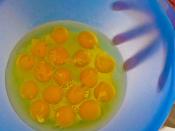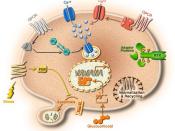Mitochondria provide the energy a cell needs to move, divide, produce secretory products, contract - in short, they are the power centers of the cell. They are about the size of bacteria but may have different shapes depending on the cell type.
Mitochondria are membrane-bound organelles, and like the nucleus have a double membrane. The outer membrane is fairly smooth. But the inner membrane is highly convoluted, forming folds called cristae. The cristae greatly increase the inner membrane's surface area. It is on these cristae that food (sugar) is combined with oxygen to produce ATP - the primary energy source for the cell.
Cells need energy for other processes such as the synthesis of proteins from amino-acids and the replication of DNA. This energy usually comes from the breakdown of glucose; though fats and proteins can also be used a sources of energy. Glucose is a stable chemical: it does not just breakdown releasing energy.
Since glucose can pass through cell membranes it is used to transport energy from one part of your body to another in your blood.
Glucose cannot be stored by cells. They must convert the glucose into glycogen. Both liver cells and muscle cells can store glycogen. Storing glucose is not possible for two reasons. Firstly it would just get out of the cell. Secondly it would have an enormous osmotic effect. Glycogen is not soluble so it cannot leak out of cells. Instead of storing tens of thousands of glucose molecules, the cell can store a few glycogen molecules which have very little osmotic effect.
ATP is very much less stable than either glucose or glycogen, so it cannot be used to store energy or to transport energy. Cells make ATP when and where they need it. Muscle cells need...



Excellent
This is one of the best esays discussing mitochondria that I have ever read, and believe me, there is alot of them. I'm interested in biology, so I started with a feeling that this wouldn't be that good, but as I read further and further it became better and better. I liked it, how about you?
3 out of 3 people found this comment useful.